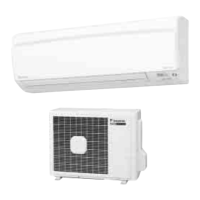Refrigerant Circuit Si18-525B
96 Refrigerant Circuit
1. Refrigerant Circuit
1.1 Outdoor Units
No. in
refrigerant
system
diagram
Symbol Name Major Function
A M1C Inverter compressor (INV)
Inverter compressor is operated on frequencies between 52 Hz and 190 Hz by using
the inverter.
25 steps
D
M1F
M2F
Inverter fan
Since the system is of air heat exchanging type, the fan is operated at 8-step rotation
speed by using the inverter.
EY1E
Electronic expansion valve
(Main: EV1)
While in heating operation, PI control is applied to keep the outlet superheated degree
of air heat exchanger constant.
FY2E
Electronic expansion valve
(Subcool: EV2)
PI control is applied to keep the outlet superheated degree of subcooling heat
exchanger constant.
G Y1S Solenoid valve (Hot gas: SVP) Used to prevent the low pressure from transient falling.
JY2S
Solenoid valve (Receiver gas
discharging: SVG)
Used to collect refrigerant to receiver.
M Y3S Four way valve Used to switch the operation mode between cooling and heating.
N S1NPH High pressure sensor Used to detect high pressure.
O S1NPL Low pressure sensor Used to detect low pressure.
PS1PH
HP pressure switch (For INV
compressor)
In order to prevent the increase of high pressure when a malfunction occurs, this
switch is activated at high pressure of 4.0 MPa or more to stop the compressor
operation.
S — Fusible plug
In order to prevent the increase of pressure when abnormal heating is caused by fire
or others, the fusible part of the plug is molten at a temperature of 70 to 75°C to
release the pressure into the atmosphere.
T—
Pressure regulating valve 1
(Receiver to discharge pipe)
This valve opens at a pressure of 2.0 to 2.7 MPa for prevention of pressure increase,
thus resulting in no damage of functional parts due to the increase of pressure in
transportation or storage.
1 R1T Thermistor (Outdoor air: Ta) Used to detect outdoor temperature, correct discharge pipe temperature, and others.
2 R2T Thermistor (Suction pipe: Ts)
Used to detect suction pipe temperature, keep the suction superheated degree
constant in heating operation, and others.
3R3T
Thermistor (INV discharge
pipe: Tdi)
Used to detect discharge pipe temperature, make the temperature protection control of
compressor, and others.
4R4T
Thermistor (Heat exchanger
deicer: Tb)
Used to detect liquid pipe temperature of air heat exchanger, determine defrosting
operation, and others.
5R5T
Thermistor (Subcooling heat
exchanger gas pipe: Tsh)
Used to detect gas pipe temperature on the evaporation side of subcooling heat
exchanger, keep the superheated degree at the outlet of subcooling heat exchanger
constant, and others.

